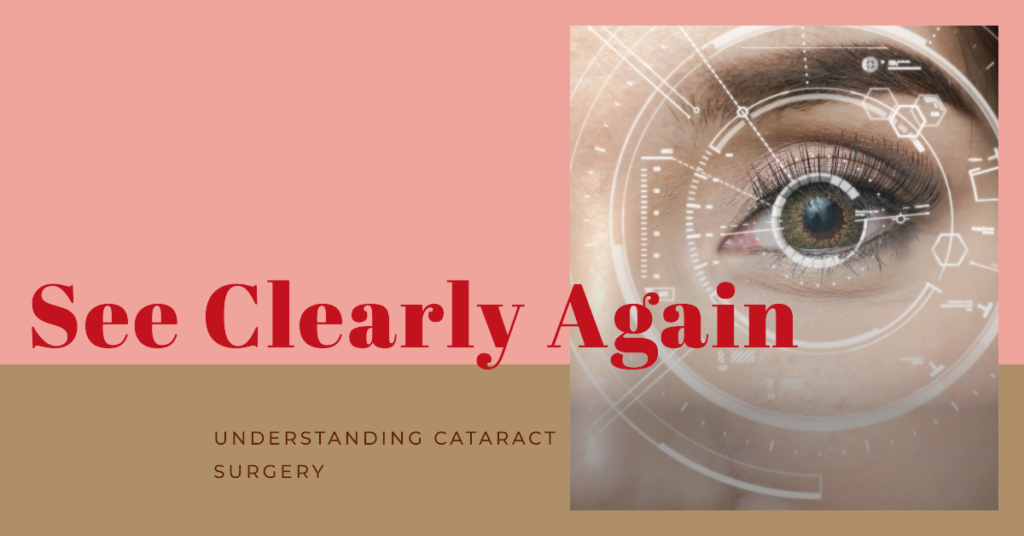Cataract surgery is a remarkable medical procedure that can dramatically improve your vision and quality of life. However, if you’re an avid golfer, you might be wondering about the timing and safety of returning to the golf course after undergoing this surgery.
This comprehensive guide delves deep into the intricacies of playing golf after cataract surgery, ensuring you have all the information you need to make informed decisions about your post-surgery activities.
Can I Play Golf After Cataract Surgery? And Why is it Important to Know?
Yes, you can golf after cataract surgery. Following cataract surgery, many individuals are eager to resume their favorite outdoor activities, such as golf. The good news is that, in most cases, it’s possible to return to the golf course after the procedure. However, the timing of your return and the precautions you should take may vary depending on your specific circumstances. It’s crucial to consult your eye surgeon or ophthalmologist for personalized guidance and to ensure you follow the appropriate safety measures to protect your healing eyes while enjoying the game.
But why should you pay attention to your post-surgery situation? Let’s dig in.
a. Understanding Cataract Surgery

Cataracts, often associated with aging, are a common eye condition that causes the lens of the eye to become cloudy, resulting in progressively blurred vision. Fortunately, cataract surgery has evolved into a routine and highly effective procedure. During the surgery, the cloudy lens is removed and replaced with an artificial intraocular lens (IOL), which can significantly enhance visual clarity.
Cataract surgery is typically performed on an outpatient basis and lasts only about 15 to 30 minutes. It’s performed one eye at a time, with a few weeks’ gap between surgeries if both eyes require treatment. The recovery process after cataract surgery is generally smooth and allows most individuals to regain their vision relatively quickly.
However, waiting after cataract surgery is essential for several reasons:
-
Healing Time: Cataract surgery involves removing the eye’s cloudy natural lens and replacing it with an artificial intraocular lens (IOL). The eye needs time to heal and adjust to the new IOL. Rushing back into strenuous activities like golf too soon can strain the healing eye unnecessarily.
-
Risk of Injury: Playing golf involves physical movements, including bending, swinging, and ball tracking. During the early stages of recovery, your eye may still be sensitive to injury. An accidental bump or excessive strain could lead to complications.
-
Infection Risk: Your eye surgeon will likely prescribe post-operative medications, including eye drops, to prevent infection and reduce inflammation. Adhering to the prescribed medication schedule and waiting until your surgeon gives the green light reduces the risk of disease, which could be exacerbated by outdoor exposure.
-
Vision Stabilization: While many patients experience improved vision shortly after surgery, their visual acuity may change and stabilize over a few weeks. Waiting allows your imagination to settle to its optimal state, ensuring you can enjoy your golfing experience fully.
So, how long should you have to wait after your recovery?
Recovery Timeline After Your Successful Cataract Surgery
Understanding the recovery timeline after cataract surgery is crucial for planning your return to activities like golf. The immediate post-surgery period might involve some discomfort, mild irritation, or foreign body sensation in the eye that had the procedure. However, these symptoms typically diminish within a day or two.
In terms of vision improvement, you may notice changes almost immediately after the surgery. Many patients report clearer and sharper vision within hours. However, it’s essential to remember that your idea will continue to improve over the next few weeks as your eye heals and adapts to the new intraocular lens.
It’s common for patients to experience variations in vision quality during the recovery period. Some days may be better than others, but this is entirely normal. Your surgeon will schedule follow-up appointments to monitor your progress and ensure your eye is healing as expected.
Clear vision is vital for a perfect swing in golf. Cataract surgery can significantly improve visual acuity, enhancing golf performance. With sharper images, you can assess distances accurately, make better shot selections, and maintain swing accuracy.
So, if you have been considering cataract surgery, envision a future filled with clear vision and a better golf game.
Preparing For Golfing After Cataract Surgery
After cataract surgery, it is essential to take precautions when getting back to golfing. Consult your doctor, use protective eyewear, and gradually increase your activity level to ensure a safe and enjoyable golfing experience.
a. Consultation With An Ophthalmologist Before Resuming Golf:
It is crucial to consult with an ophthalmologist before returning to the golf course after cataract surgery. The ophthalmologist will evaluate your eyes and determine if you can resume golfing. During the consultation, the ophthalmologist will consider factors such as the type of cataract surgery you had, the healing progress, any complications or risks, and your overall eye health.
This consultation will ensure that you clearly understand your readiness to golf post-surgery and any precautions you need to take.
b. Determining The Appropriate Time To Return To The Golf Course:
Determining the appropriate time to return to the golf course depends on various factors, including your healing process. While each case is unique, there are general guidelines you can follow. Your ophthalmologist will likely advise you to wait for a certain period after surgery before engaging in strenuous activities, including golfing.
Depending on how well your eyes are healing, this period may range from a few days to a few weeks. Following your ophthalmologist’s recommendations is essential to avoid any potential complications and ensure a successful recovery.
c. Ensuring Your Eyes Are Adequately Protected During Play:
Protecting your eyes while golfing after cataract surgery is of utmost importance. Here are some measures to ensure your eyes are adequately protected:
- Wear sunglasses: Invest in high-quality sunglasses that offer UV protection and optimal glare reduction. These sunglasses will shield your eyes from harmful UV rays and prevent any discomfort caused by bright sunlight.
- Consider protective eyewear: Depending on your ophthalmologist’s recommendations, you may need to wear additional eyewear while golfing. These eyewear options can include goggles or sports-specific glasses designed to safeguard against impact.
- Use eye drops as needed: After cataract surgery, your eyes may still be sensitive or dry. To alleviate any discomfort, make sure to use the prescribed eye drops as recommended by your ophthalmologist. These drops will help keep your eyes lubricated throughout your game.
- Be cautious during specific conditions: Be mindful of playing golf in extreme weather conditions such as strong winds or dusty environments. Additionally, stay cautious during activities such as bunker shots or driving off the tee to avoid debris or particles entering your eyes.
Following these protective measures ensures that your eyes remain safe and comfortable while enjoying a game of golf after cataract surgery. Remember that every individual’s recovery process is unique, and it’s essential to consult with your ophthalmologist for personalized advice.
Golfing Safety Tips After Cataract Surgery
Golfing after cataract surgery requires caution. Follow these safety tips to ensure a smooth recovery and protect your eyes on the course.
a. Adequate Sun Protection And UV-blocking sunglasses
- Wear a wide-brimmed hat and apply sunscreen with an SPF of at least 30 to protect your eyes and skin from harmful UV rays.
- Invest in a pair of UV-blocking sunglasses designed for outdoor activities like golfing.
- Look for sunglasses that provide 100% UVA and UVB protection to shield your eyes from short-term and long-term sun damage.
- Choose sunglasses with a wraparound design to minimize peripheral glare and protect your eyes from all angles.
- Polarized lenses can reduce glare and enhance visual clarity, which is beneficial when tracking the ball on sunny days.
- Remember to clean your sunglasses regularly to maintain optimal visual acuity.
b. Proper Eye Care And Hygiene On The Golf Course
- Keep your eyes moisturized by blinking frequently and using artificial tears if necessary to prevent dryness or irritation.
- Avoid touching or rubbing your eyes during or after golfing to minimize the risk of infection.
- If you wear contact lenses, opt for daily disposables to reduce the chances of contamination or irritation.
- Protective eyewear, such as shatterproof glasses or sports goggles, prevents injury from flying golf balls or errant swings.
- Be mindful of dust, pollen, and other allergens on the golf course, as they can exacerbate eye irritations or allergies.
- Carry a clean cloth or tissue to wipe away sweat, debris, or any foreign particles that may come into contact with your eyes.
c. Recognizing Potential Complications And When To Seek Medical Attention
- While golfing after cataract surgery is generally safe, being aware of potential complications is essential.
- If you experience severe eye pain, sudden changes in vision, or excessive redness or swelling, seek immediate medical attention.
- Blurry or distorted vision, floaters, or light flashes can also be signs of complications and should be reported to your eye doctor.
- It’s crucial not to ignore any persistent discomfort or abnormalities in the affected eye, as early intervention can prevent further complications.
- Regular follow-up appointments with your eye doctor are essential to monitor your eye health and ensure a smooth recovery.
- By paying attention to changes in your vision and promptly seeking medical attention, you can safeguard your eye health post-cataract surgery.
Remember, golfing can be enjoyable after cataract surgery, but taking precautions and prioritizing your eye health is essential. You can safely enjoy golf while protecting your newly improved vision with adequate sun protection, proper eye care and hygiene, and recognizing potential complications.
Can I Golf After Cataract Surgery? Addressing Common Concerns
After cataract surgery, it is generally safe to resume golfing if you take certain precautions. Ensure your eye is fully healed, wear protective sunglasses, and avoid straining your eyes. Nonetheless, it is advisable to consult with your eye surgeon before returning to the golf course.
a. Common Fears And Misconceptions About Golfing Post-Surgery:
- Fear of injuring the eyes: One common concern is that golfing after cataract surgery may cause eye injury. However, it’s important to note that the risk of eye injury is minimal with proper precautions.
- Worry about vision changes: Some people may worry that golfing can affect their vision after cataract surgery. While it is normal to experience some fluctuation in sight during the healing process, golfing does not pose a significant risk to your visual recovery.
- Concerns about physical strain: Golfing involves physical activity, and some individuals may be concerned about the pressure it can put on the eyes after cataract surgery. However, following your doctor’s advice and taking necessary precautions, you can safely enjoy golfing as a post-surgery activity.
b. Clarifying The Risks And Precautions Associated With Golfing After Cataract Surgery:
- Timing of golfing: It is recommended to wait for a certain period after cataract surgery before resuming golfing. Your eye doctor will advise you on when it is safe for you to engage in physical activities like golfing. Following their guidance ensures that your eyes heal properly and minimizes potential risks.
- Protective eyewear: Wearing protective eyewear, such as sunglasses with UV protection or sports goggles, while golfing can help shield your eyes from harmful UV rays, dust, and other debris. These precautions can reduce the chance of complications and maintain your eye health.
- Avoid strenuous activities: While golfing is generally a low-impact sport, it still involves some physical exertion. To protect your eyes during the healing process, avoiding heavy lifting, bending, or other strenuous activities that may strain your eyes or increase intraocular pressure is advisable.
- Proper hygiene: Maintaining good hygiene is crucial after cataract surgery. Wash your hands thoroughly before touching your eyes or contact lenses to prevent any potential infections. Additionally, avoid rubbing or putting excessive pressure on your eyes while golfing.
c. The Role Of Physical Activity And Exercise In The Healing Process:
- Enhances blood circulation: Engaging in moderate physical activities like golfing promotes blood flow throughout the body, including the eyes. This increased circulation aids in healing by providing essential nutrients and oxygen to the eye tissues.
- Reduces the risk of complications: Regular exercise, including golfing, can help reduce the risk of certain post-surgical complications, such as blood clots. Staying active can also contribute to better overall health, indirectly supporting your eyes’ healing.
- Boosts mood and well-being: Exercise releases endorphins, the ‘feel-good’ hormones, promoting well-being and reducing stress. After cataract surgery, engaging in activities like golfing can contribute to a positive mindset, enhancing your recovery.
Remember to consult your eye doctor before resuming any physical activities post-cataract surgery. They will provide personalized advice based on your situation to ensure a safe and optimal healing process.
Safeguarding Your Vision On The Golf Course
Discover if it’s possible to resume golfing after undergoing cataract surgery and how to protect your eyes while playing on the golf course. Ensure your vision stays safe and your game remains on par.
Playing golf is a beloved pastime for many, and having cataract surgery shouldn’t hinder your enjoyment. However, it’s essential to take certain precautions to ensure the safety of your eyes and maintain visual clarity on the golf course.
Implementing the following strategies can minimize eye strain and fatigue, protect your eyes from environmental hazards, and ensure an optimal golfing experience.
a. Strategies To Minimize Eye Strain And Fatigue While Golfing:
- Take regular breaks: Resting your eyes periodically can help alleviate eye strain and prevent fatigue. Take short breaks between shots or holes to give your eyes a chance to relax.
- Adjust your vision correction: If you wear glasses or contact lenses, ensure your prescription is current. Correcting your vision helps reduce strain and improves clarity on the course.
- Use sunglasses: Invest in good sunglasses that block harmful UV rays. Not only do they shield your eyes from the sun, but they also offer protection against dust, wind, and other debris that could irritate your eyes.
- Blink frequently: Remember to blink often, as frequent blinking helps moisturize your eyes and prevents dryness or irritation.
- Maintain good lighting conditions: Ensure proper lighting when examining your shots or reading the green. Avoid playing in dimly lit areas, as it can strain your eyes and affect your depth perception.
b. Protecting Your Eyes From Environmental Hazards On The Course:
- Wear safety glasses: Besides sunglasses, consider wearing safety glasses specifically designed for sports. They protect against flying golf balls, branches, or sand particles.
- Be cautious with contact lenses: If you wear contact lenses, be mindful of potential irritants on the golf course, such as dust or pollen. Consider using eye drops to keep your eyes lubricated and remove any particles that may cause discomfort.
- Shield your eyes from the wind: On windy days, shield your eyes with a hat or visor to prevent dryness and ensure clear vision.
- Stay hydrated: Proper hydration is essential for maintaining good eye health. Drink plenty of water to keep your eyes well-nourished, especially during hot and sunny days.
c. Tips For Maintaining Visual Clarity During Gameplay:
- Keep your eyes on the ball: Focus on tracking the ball closely with your eyes throughout your swing. Maintaining a clear view of the ball helps optimize your shot accuracy.
- Use contrast-enhancing golf balls: Some golf balls are designed with color technology to enhance visibility. Consider using high-visibility balls that provide better contrast against the greenery.
- Clean your glasses or sunglasses regularly: Dirty lenses can obstruct your vision, so keep them clean using a lens cleaner and microfiber cloth.
- Practice good eye hygiene: Avoid touching your eyes with dirty hands, leading to irritation or infection. Wash your hands frequently and avoid rubbing your eyes during gameplay.
Following and incorporating these strategies into your golfing routine can safeguard your vision and allow you to enjoy a pleasant golfing experience after cataract surgery. Remember, protecting your eyes should always be a top priority on the course. You can also check out our list of 8 best golf balls if you need to buy a new one after recovering from surgery.
Frequently Asked Questions Of Can I Golf After Cataract Surgery
a. Can Cataracts Affect Your Golf Game?
Cataracts can impact your golf game due to blurred vision and difficulty judging distances accurately.
b. What Activities Should Be Avoided After Cataract Surgery?
After cataract surgery, it’s important to avoid strenuous activities, such as heavy lifting or bending.
c. How Soon Can I Play Sports After Cataract Surgery?
You can usually play sports within a few days or weeks after cataract surgery.
d. Can I Play Golf After Laser Eye Surgery?
Yes, you can play golf after laser eye surgery.
Final Words
Golfing after cataract surgery is generally safe and possible, but it is crucial to consult your ophthalmologist and follow their guidelines. The recovery period is essential for allowing your eyes to heal properly. It is necessary to wear protective eyewear to shield your eyes from direct sunlight and potential injuries on the golf course.
Take breaks during your game to rest your eyes and prevent strain. Remember to stay hydrated and listen to your body’s signals if you experience any discomfort. Maintaining sound eye health is essential for your overall well-being, so don’t hesitate to seek professional advice before returning to the golf course post-surgery.
Enjoy the sport you love while prioritizing your eye health for a better, clearer vision on and off the golf course.






